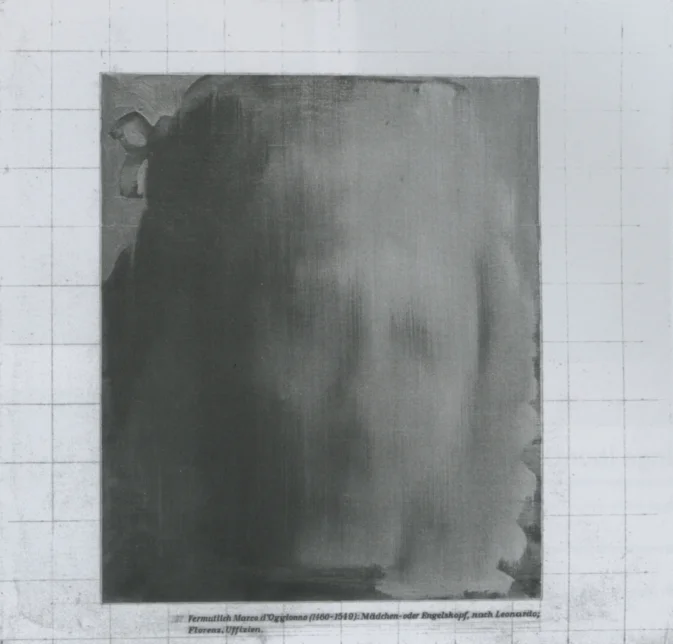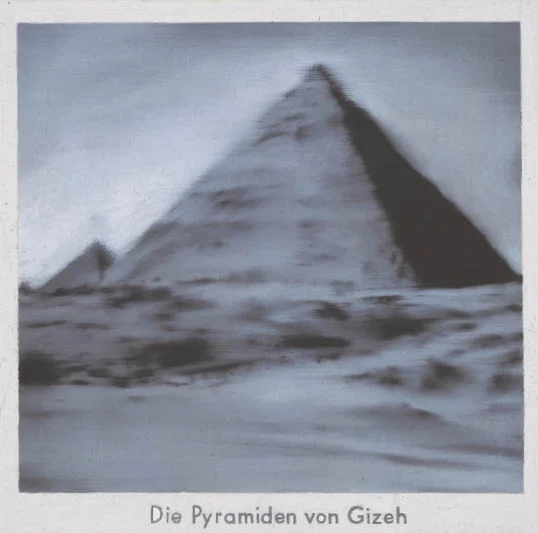
I swear I will cut back on Gerhard Richter stanposting when Richter cuts back on wild things to stan.
While looking for examples of the way Richter considers his catalogue raisonné as a construct separate from a chronology, this painting caught my eye. Engelskopf, or Angel’s Head, [CR 48-7], is dated to 1963, where it comes after CR 13, CR 14 and CR 25-a, and is followed by CR 14-a and CR 15.
That 1963 date makes Engelskopf is one of the earliest photopaintings, but also one of the very first to include a caption text, which made Richter’s sourcing of reproduced images clear. It’s also Richter’s first art historical reference; except for Philipp Wilhelm, a painting of a newspaper clipping of a painted portrait, from 1964, it’ll be a long time before Richter directly references earlier artworks.
But about that date. Other references to Engelskopf, including Richter’s authorized biography, give it a date of 1963/1965. Its exhibition history says it was shown in 1964, in the Neue Realisten group show with Konrad Leug and Sigmar Polke. So appending a 1965 date implies it was unfinished, or reworked, before Richter included it in his 1966-67 solo exhibition at Galerie René Block in Berlin. It has not been seen publicly since.

Engelskopf is the only CR 48 work dating from 1963. Fifteen others, numbered CR 48-1 to CR 48-17—but not chronologically, and there is no CR 48-11—are from 1964 and 1965. In his Bilderverzeichnis (Picture Inventory) edition in 1969, that is Richter’s first public gesture of framing his entire oeuvre, No. 48 is listed as “6 Oelskizzen [Oil sketches], 1965 50 x 50 cm.” So it makes sense if Richter wanted to go back to individually catalogue a bunch of pictures he once considered sketches, and then also try to sort them by date. But all the other CR 48s are significantly smaller than Engelskopf, like a quarter of the size. So maybe CR 48 is a bigger bucket than it first seemed.

But what is going on in Engelskopf itself? It shows a reproduction of a painting from an art reference book, with most—but not all—of the painting blurred out. The The border of the painting is outlined in the same style as the surrounding grid. There are some faintly smudgy moments, mostly on the bottom, and around the otherwise crisp, even italicized, caption below the image, which reads: “Vermutlich Marco d’Oggionno (1460-1549): Mädchen- oder Engelskopf, nach Leonardo; Florenz, Uffizien [Probably Marco d’Oggionno (1460-1549): Girl or Angel’s Head, after Leonardo, Uffizi, Florence].”
The only substantive discussion of Engelskopf I’ve found so far is also the reason for posting this at all. Here is a Google translation of Klaus Krüger’s 1995 Pantheon article about Richter and the depiction of illusion:
The grid system applied to the canvas to enlarge the photographic original is auto-referential and refers to the process of image transfer and the mediation [Medialität] of the representation. The angel’s head appears as a picture within a picture, or rather: as an image within a picture, as clearly indicated by the painted inscription, which identifies it as a reproduction from a volume of illustrations…The painting it reproduces is itself only a copy, which in turn—as the caption states—can only be “assumed” to have come from the hand of the Milanese painter Marco d’Oggiono [Richter spells it with two n’s, btw. -ed.]. It recreates an original by Leonardo, which itself is lost. In the light of this perspective on a lost reality of the picture, the fact that the subject depicted is the portrait of an angel, i.e. a being whose reality per se can only be that of an imaginary image, and which a realist like Courbet famously described as “unpaintable”, also deserves attention. In this way, the deep pull of a reality of the representation that disappears into infinity—the space from which the angel comes—also gains significance in terms of content. The vertical blurring of the depiction, however, turns what appears to be a continued premonition of its lost subject in the face of the image into an immediate event in the viewer’s eyes.
So this is a lot, and it is definitely a lot for Richter to have figured out in 1963. I can imagine it taking some time, reflection, and reworking. Many other photo/clipping works from this period have their sources preserved in Atlas, but not Engelskopf. Apparently the newspaper clipping in Atlas for Folding Dryer [CR 4], 1962, is rare for showing the enlargement grid; it also reveals changes Richter made to his painted text.
What only occurred to me while failing to find Richter’s source image—which I assume is an early 20th century catalogue of Leonardo—is not just that those letters look italicized, but they’re also exquisite. As Krüger notes, the blurring is highly specific and selective. So leaving the caption clear is a choice that underscores the source and its character. But also, those letters are tiny, like 5-7 millimeters tall. Did Richter really paint them by hand? with a brush? Is that what took so long? Or was there another mechanical, lettering, or printing process involved? That would be new information about Richter’s process. To figure that out, I would like to see this work.
